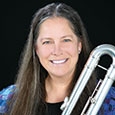Question: I will be playing contra in our local flute choir this year. Many of the scores do not have a contra part. Do I double the bass part or do I not play on these selections?
Answer: You should play the bass parts on contrabass if there is no contra part. After hearing the piece with the added depth of the contra sound, the conductor will decide whether to keep contra on the part or not.
Bass is often the lowest part in flute choir music because contrabasses were rare when flute choir music started becoming popular in the late 1970s. Few composers and arrangers at the time knew about the instrument, and as a result, they did not include it.
If you are given a piece without a contra part that was written or arranged recently, the composer may still not know about contras or else did not want them in the piece. However, as the part was given to you, assume the conductor wants contra on the part. It will not hurt anything if you play the bass part, and it may improve the piece.
Depending on the difficulty of the work and your abilities on the instrument, the bass part may need to be edited. Deciding how to do this becomes the challenge. Ask for your music ahead of the first rehearsal so you have time to look it over.
The contrabass is not as agile as the bass. The tonal response time is longer; the keys are larger and take more time to move up and down; and the sound cracks into higher pitches easily. Evaluate bass parts carefully to determine where the contra would be the most effective.
To learn how to edit a bass part, start with a work at a moderate tempo with longer note values and short predictable scale patterns. This sort of part will require the least amount of editing, and the entire piece is probably playable. Consider taking any third octave notes down an octave.
Once you feel at ease with the instrument and the piece, consider not playing during a few soft passages to vary the texture. Music is more interesting if there are textural changes. Write out by those passages or draw a circle around them. Be sure to practice leaving the notes out. If the conductor does not like it, he or she will let you know.

If a piece has extended passages of long sustained notes and you are the only contra player, be aware that the audience will be able to tell when you take a breath as the bottom will drop out. Listen for spots where other instruments are changing notes and take breaths in those places. Try playing in the same octave as the basses to blend your sound into theirs. If there are no such options, taper elegantly and try taking a breath just before a downbeat. Come in on the downbeat at the same dynamic level you were playing before the breath.
For pieces with faster tempos, less time to breathe, leaps to the bottom notes of the instrument, arpeggios, low turn-arounds and fast tongued notes, editing takes more thought and planning. (Memorize and add difficult spots into your daily practice.)
Start with the playable passages of the more challenging pieces and during rehearsals, listen to the basses playing the parts you are temporarily leaving out. When confronted with an extended passage of fast, tongued notes, consider playing only single notes on the main beats of the bar. If a measure of 4/4 is all tongued 16th notes, play only four short notes in that measure; one each on beats 1, 2, 3 and 4. The notes will match the pitches on those beats. If there is a mixture of 16th and 8ths, play the 8ths.
Some sort of marking might be needed as a reminder of the notes you have chosen. I like to draw a new stem in the opposite direction of the printed one. In a group of 16th notes, draw a new stem from the first note of each group. A colored mark from a highlighter pen also makes them easier to pick out.
The secret to playing all of the notes of extended tongued passages successfully is to make the air do the work. Blow through the notes; make them as long as possible. Keep your tongue soft and broad and the air strong.
Fast slurred passages may require extra practicing. Because the lyrical aspect of the passage is likely to be disrupted by playing only some of the notes, it is best to play all of the notes or don’t play at all. Stay with the beat or do not play.
Slow slurred passages will be affected by breathing issues. Be sure to start with a good breath. Try playing softer, take more frequent short breaths, or occasionally leave out less important notes like the second note of a group of four to take a breath. Strive to take in more air with each inhale and use it more efficiently.
Playing only on the downbeat of 3/4 bars can help a waltz-like piece or section be more effective. Given a strong downbeat, the other parts will bounce off your note.
Dynamics play a big role when deciding whether or not to play a passage. The contra is certainly capable of playing softly, but since the basses are already covering this part, you can provide additional dynamic contrast by not playing when it is piano or softer.
Once edits have been made, practice is essential. It is surprisingly difficult to play some notes and ignore others. If the instrument belongs to the choir, be sure to ask to take it home or to come early to rehearsal and practice. The contra takes time to learn to play confidently. You can work out rhythm problems at home on another flute, but there is no substitute for hands-on experience with a contra.
Send your questions to Ask the Pro to editor@flutetalkmagazine.com






